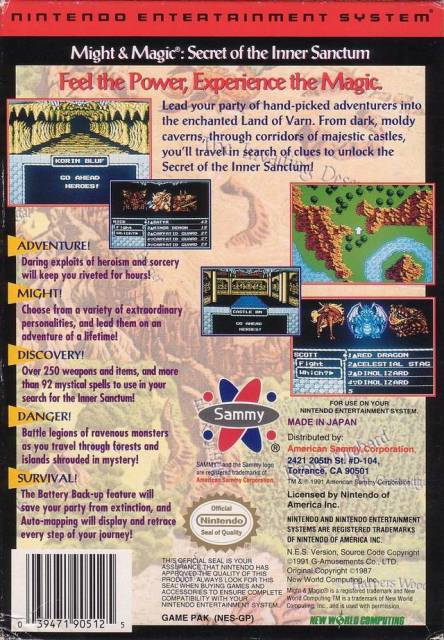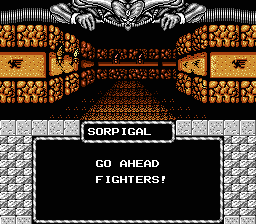Overview

The first of a series of Might & Magic RPG titles,
Secret to the Inner Sanctum would introduce an open, non-linear world to players as they sought out quests, fought terrible creatures, and explored the vast world laid at their feet. It is considered a pioneering dungeon crawl from the eighties and introduced several innovative features which would help build the foundation for those found in titles such as Bethesda's
Elder Scrolls series. As was popular at the time, many of its conventions appear based on concepts drawn up within the Dungeons and Dragons rule set by TSR.
The game was also notable for including a large, color map of the world of Varn.
Story

The original boxed copies of the game as it appeared on personal computers did not boast about a storyline and instead enticed players by advertising what it had to offer by challenging them with 200 monsters, 94 different spells, and 250 items of magic, all scattered across the world of Varn.
It was only until somewhat later in the game as players continued to explore the world that an actual story began to form around the "Secret" hinted at within the title along with a quest to capture an escaped criminal. Although the game appeared devoted to traditional swords and sorcery, it would also drop in elements of science fiction that would become part of the series' extensive backstory as developed through the following sequels.
Gameplay

The gameplay was centered around a six person party with the world seen from a first person perspective utilizing rudimentary 3D graphics for the outdoor locations and indoor dungeons. Monsters along with certain other encounters were displayed as 2D pictures. As was the norm at the time for several RPG titles, movement was centered aroud a grid based scheme which meant 90 degree turns and square-based movement forward or back.
The game was also considered quite detailed as well as difficult. Players were required to maintain a stock of food in order to be able to rest outside of an in to regain hit and spell points. Bashing open locked doors would often set off traps if they were not disarmed. Leveling was not automatic.
Once a character had earned the requisite experience, it must be spent at a training ground in order to improve their statistics and abilities. Gems were often required to cast higher level spells and characters could also die from old age (natural or not), although the proper spells could alleviate its effects. Characters could also be afflicted with a number of debilitating conditions which often proved incredibly fatal to starting parties. Sex and alignment would also restrict certain characters from entering specific areas or in equipping certain items.
Saves are handled at Inns within each town making it particularly dangerous to get caught far from their walls in dangerous territory. They are the only places where players may save the game.
Towns and dungeons were all divided into 16 by 16 squares and the game used a
grid-based movement system with 90 degree turns.
Races
The game allows the player to select among five different races in building their characters. As with most other RPGs, certain races have slightly better statistics in certain areas and others, but the emphasis appears to be more on how resistant each one is against certain conditions such as falling prey to sleep spells or being more resistant to poison.
The five races are:
- Human - Strong resistance to fear and some resistance to sleep spells. Average statistics make this race a good choice without any glaring weaknesses.
- Elf - They have a strong resistance to fear and are generally excellent at spellcasting
- Dwarf - Some resistance to poison, stronger and hardier than the other races. They make excellent fighters but poor spellcasters.
- Gnome - Nimble and quick, they make excellent thieves and decent spellcasters.
- Half-Orc - They have a moderate resistance to sleep spells, are decently strong, and can make great fighters.
Statistics

The maximum value for any one statistic is 18, although this can change depending on several factors based on spells or the effects of certain items. However, if any statistic drops to 0, it will result in immediate death for that character.
The basic statistics used in the game seem derived from the Dungeons and Dragons model of statistics, although carry different names so as to differentiate themselves. They are:
- Intellect - General knowledge. Important to sorcerers as it can affect spell points. Important to archers later on at higher levels as they begin learning sorcerer spells.
- Might - Raw strength. Important to any fighting class such as Knights and Paladins. Affects the damage a character can inflict in melee combat.
- Personality - A character's general degree of appeal to others. Particularly important to clerics as it affects their pool of spell points. Important to paladins when, at higher levels, they begin learning cleric spells.
- Endurance - Stamina. Affects how many hit points a character initially has to start with and will gain every time they level. Particularly important to fighters.
- Speed - Agility and general quickness affecting initiative. A faster character improves (increases) their Armor Class rating making them harder to hit.
- Accuracy - A character's ability to land hits during combat. This is particularly important to archers.
- Luck - Measures the general chances of a character succeeding when all else seems to have failed. Random and unpredictable.
Classes

Several classes are available for players to choose from in building their party of adventurers.
- Knight - These are considered the warriors of the game in being able to use any item or armor aside from those exclusively designed for another class or have an opposite alignment. They are able to attack more than once every round at higher levels.
- Paladin - While not quite as good as a Knight in combat, they are able to wield and equip as many items as they can with the same restrictions. At higher levels, they are also able to cast Clerical spells.
- Archer - These are the missile experts of the party and are able to use any weapon. Unlike the Paladin, they are also able to use missile weapons even in hand-to-hand combat. At higher levels, they are also able to cast Sorceror spells. They are restricted in the kind of armor that they can wear, however, such as chain mail or any lighter armor being the only types available for them and they cannot use a shield.
- Cleric - The traditional healer class, they can only wear light armor but they can also carry a shield. Weapons are restricted to a club, mace, flail, a staff, or a hammer. They cannot use ranged weapons such as bows. At higher levels, their healing abilities come in extremely valuable much further into the game. They are also the travel experts of Varn with spells that can teleport a party out from a dungeon, to a town for a quick rest, or enable them to walk on water to reach special areas.
- Sorceror - They can only wear padded armor and their choice of weapons are extremely limited and it almost goes without saying that they can't carry a shield. However, their spells more than make up this lack of physical protection and offensive ability with some of the most devastating attacks in the game.
- Robber - The traditional thief of the game, what they lack in offensive and defensive ability are made up with their talent for disarming traps and locks. They can fight as well as a cleric, but are far better at keeping the party safe from poison gas or fireballs erupting from chests.
Character Status

In addition to their class and race, characters have a number of other statistics that players will need to keep track of during the game.
- Level - This is a measure of how experienced a character is. Characters start out at level 1 and can only gain levels once enough experience is earned and the necessary training is purchased.
- Spell Points - A measure of how many points are available to any one character for use with spells. Certain spells have higher point requirements than others.
- Hit Points - The number of hit points a character has remaining. At zero hit points, a character does not necessarily die. Instead, they fall unconscious. However, if they suffer anymore damage after reaching zero, death is the only result.
- Armor Class - The higher this number, the more resistant a character is to damage. Armor, spells, shields, and speed are among the factors that can help determine it.
- Age - Characters start at 18 years of age and grow older as the game continues on. As they become older, their skills begin to deteriorate and vital statistics will begin to drop. After around an age of 80, the character can actually die from resting overnight. Age can be delayed or reversed using spells or in discovering special locations.
- Experience Points - These are earned from defeating monsters and quests. These determine whether a character is ready to advance to the next level through training. The point requirements for reaching the next level usually double.
- Gems - This measures the number of gems that a character is carrying. Gems are valuable as they are consumed in order to cast many higher level spells.
- Gold - The coin of the realm earned in a variety of ways whether it is from monsters or in discovering long lost treasures.
- Food - Characters start with ten food units (up to a maximum of 40). One food unit represents a day's rations and is consumed when camping to replenish hit points and spell points during rest.
- Condition - A character's current status, whether they are asleep, poisoned, dead, etc..
Each character also has their own backpack which can carry a maximum of six items.
Alignment
There are no absolutes in Might & Magic nor does this affect the story progression of the game. Instead, it largely determines certain restrictions such as whether a piece of equipment can be used or whether a particular character can enter specific areas.
Locations
Five towns are scattered throughout the land of Varn, each offering their own sets of challenges. The player was not implicitly told where to go, leaving it to their own inquisitive nature to discover where they should head off to next and who to speak to in order to find the next quest. In addition to the towns, many dungeons and secret locations are also scattered throughout the game.
Towns share many of the same services.
- Shops - Where supplies, such as new armor and food, can be purchased.
- Temples - Where sick or injured characters can be healed.
- Training Grounds - Important for advancing character levels once enough experience has been earned.
- Inns - Where characters can safely rest and where saves can be made.
Combat

Generic encounters were randomly generated and would often give the player several choices. If monsters were surprised, the player had the option to ignore them or initiate combat. If the monsters surprised the player's party, combat would immediately begin. If both parties simply encountered each other, the player would also be able to decide what they should do next.
Players could decide simply to attack the monsters, or they could try and bribe them which usually meant giving them gems or valuable food. Players could also attempt to surrender at which point they will be dropped off at a random, and more dangerous, location within the region with all of their food, gold, and gems confiscated. Failing at either of these actions will throw the party into combat.
Log in to comment